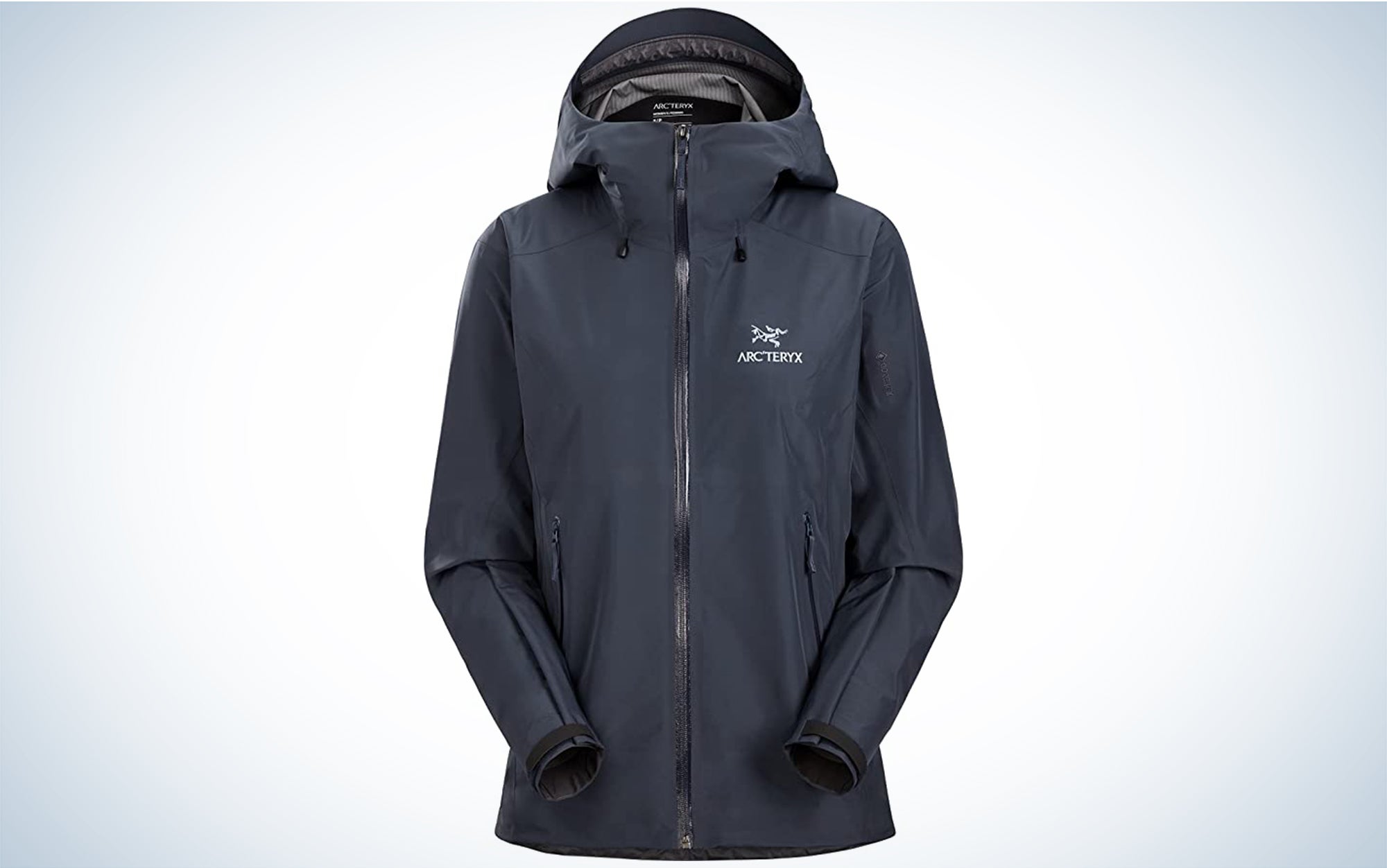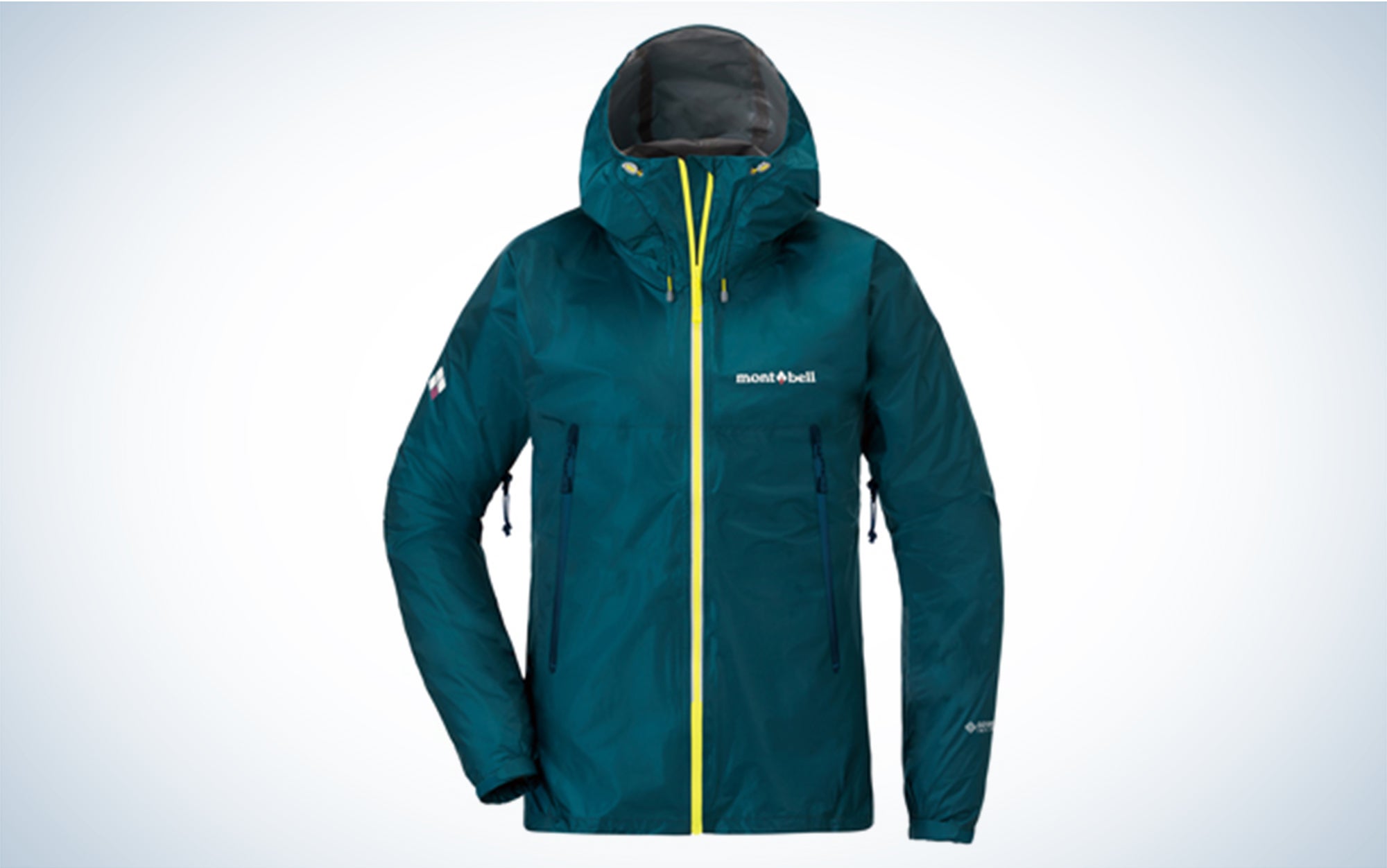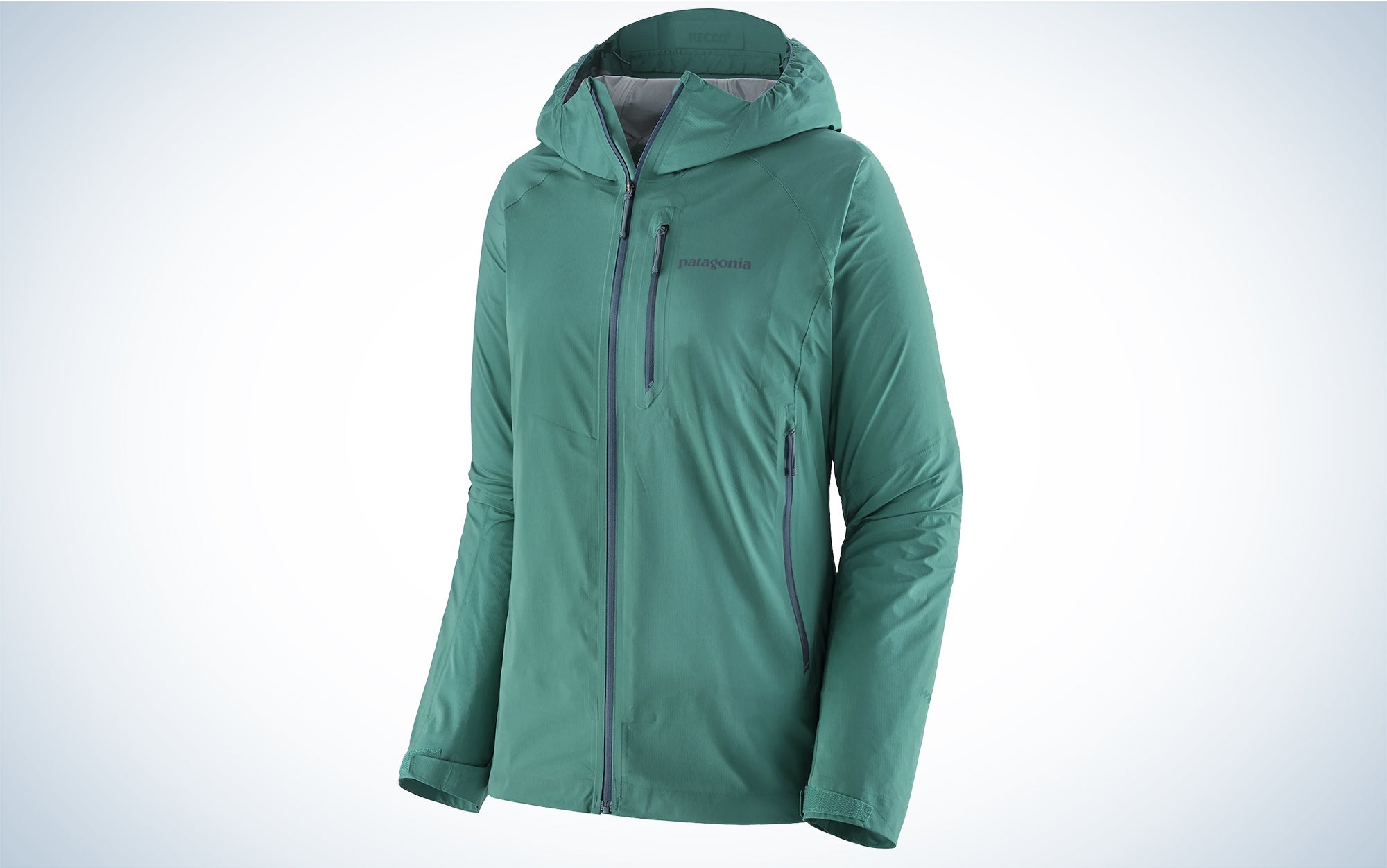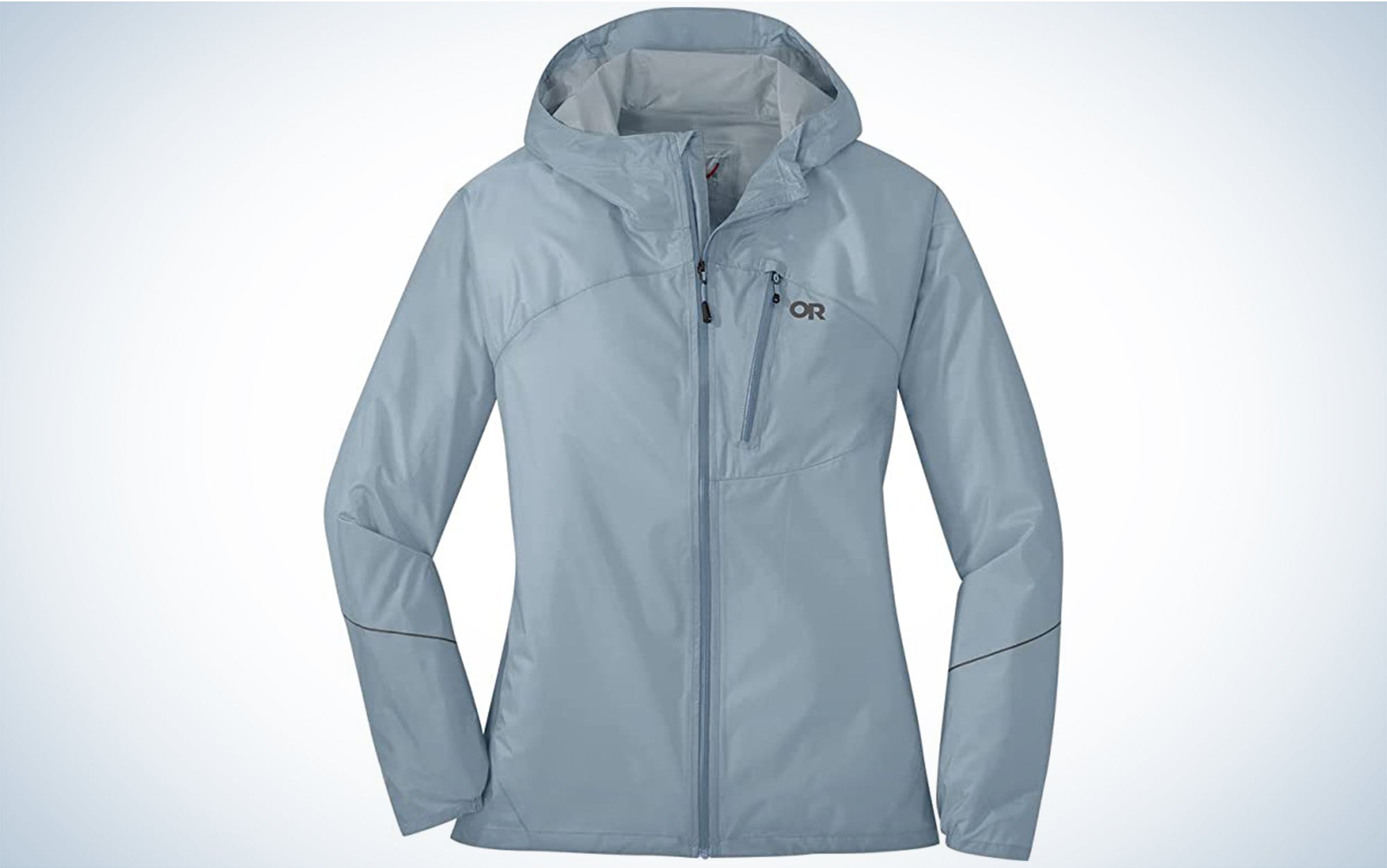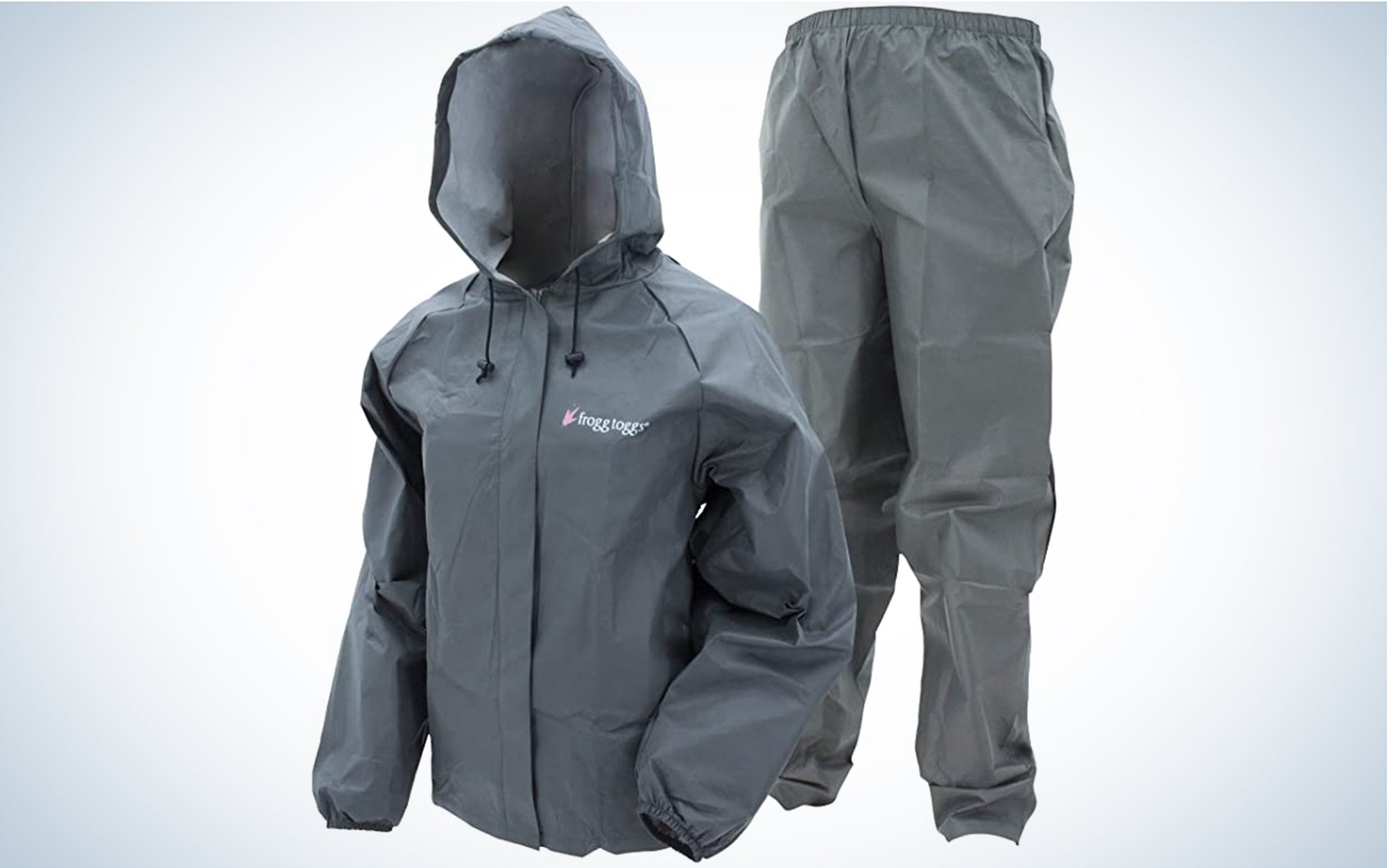The Best Backpacking Rain Jackets of 2023
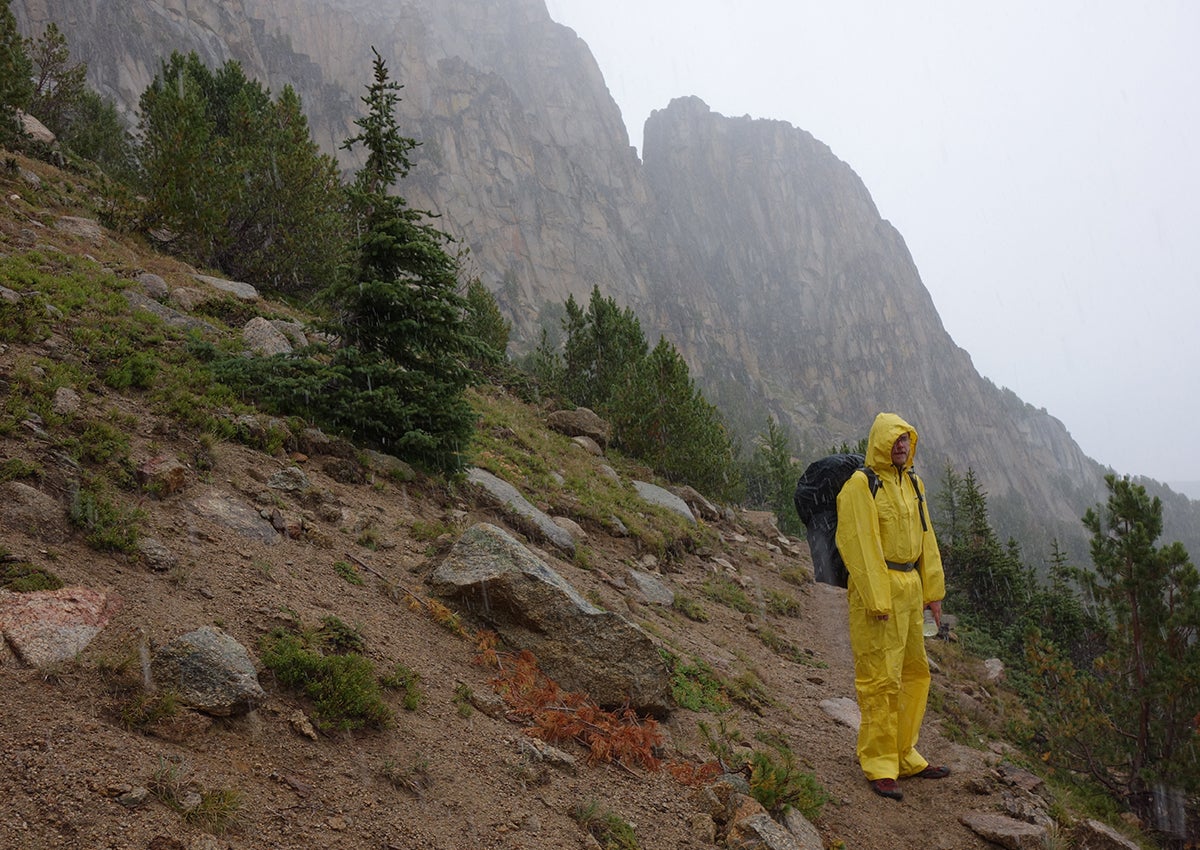
We may earn revenue from the products available on this page and participate in affiliate programs. Learn More ›
Spend enough time outdoors and you’ll end up with a pretty dialed-in layering system: baselayer, insulation layer, and backpacking rain jacket. That last part of the puzzle is usually the trickiest. While there are plenty of heavy-duty shell layers that can protect you from monsoons or blizzards, fast days on the trail mean you’ll get soaked from your own sweat. What you want is just the shell: nothing more, nothing less. To find the right lightweight shell for your next backcountry trip, I checked out the best backpacking rain jackets from Arc’teryx, Montbell, Patagonia, Outdoor Research, and Frogg Toggs.
- Best Overall: Arc’teryx Beta LT
- Best UL: Montbell Versalite
- Most Eco-Friendly: Patagonia Storm10
- Most Inclusive Sizing: Outdoor Research Helium
- Best Budget: Frogg Toggs Ultra-Lite Suit
| Rain Jacket | Price | Sizes | Weight | Waterproofing | Pit Zips | Wet-out test | Shower test | Wind Test | Rip Test |
| Arc’teryx Beta LT | $450 | Men’s: XS-XXXL Women’s: XXS-XXL |
8.5 oz | 3L GORE-TEX | No | Pass | Dry | Great | Pass |
| Patagonia Storm10 | $330 | Men’s: XS-XXL Women’s: XXS-XL |
7.8 oz | H2No Performance Standard | Yes | Pass | Slightly wet | Fair | Pass |
| Montbell Versalite | $250 | Men’s: S-XL Women’s: S-XL |
5.7 oz | GORE-TEX Infinium Windstopper | Yes | Slightly wet | Dry | Fair | Pass |
| Outdoor Research Helium | $159 | Men’s: S-XXXL Women’s: XS-4X |
6 oz | Pertex Shield Diamond Fuse 2.5L | No | Fail | Dry | Fair | Pass |
| Frogg Toggs Ultra-Lite | $30 | Men’s: S-XXXL Women’s: S-XXL |
4.6 oz | DriPore Gen 2 | No | Pass | Wet | Good | Tore on the rock |
| Outdoor Vitals Tushar Rain Jacket | $230 | Men’s X-XX Women’s S-3X |
7.4 oz | Toray Torain | Yes | TK | Dry | TK | TK |
How I Tested Lightweight Rain Jackets
The rain jackets in my test were assessed both in the field—from trail running to skiing to hiking—as well as using a series of controlled tests.
Waterproofing Test
I placed each rain jacket on the ground and then poured a small amount of water on top of the outside of the hood, with a seam under each pool of water. These were then left for 24 hours, after which I checked to see which had “wetted out,” whether the water had soaked through to the inside of the jacket.
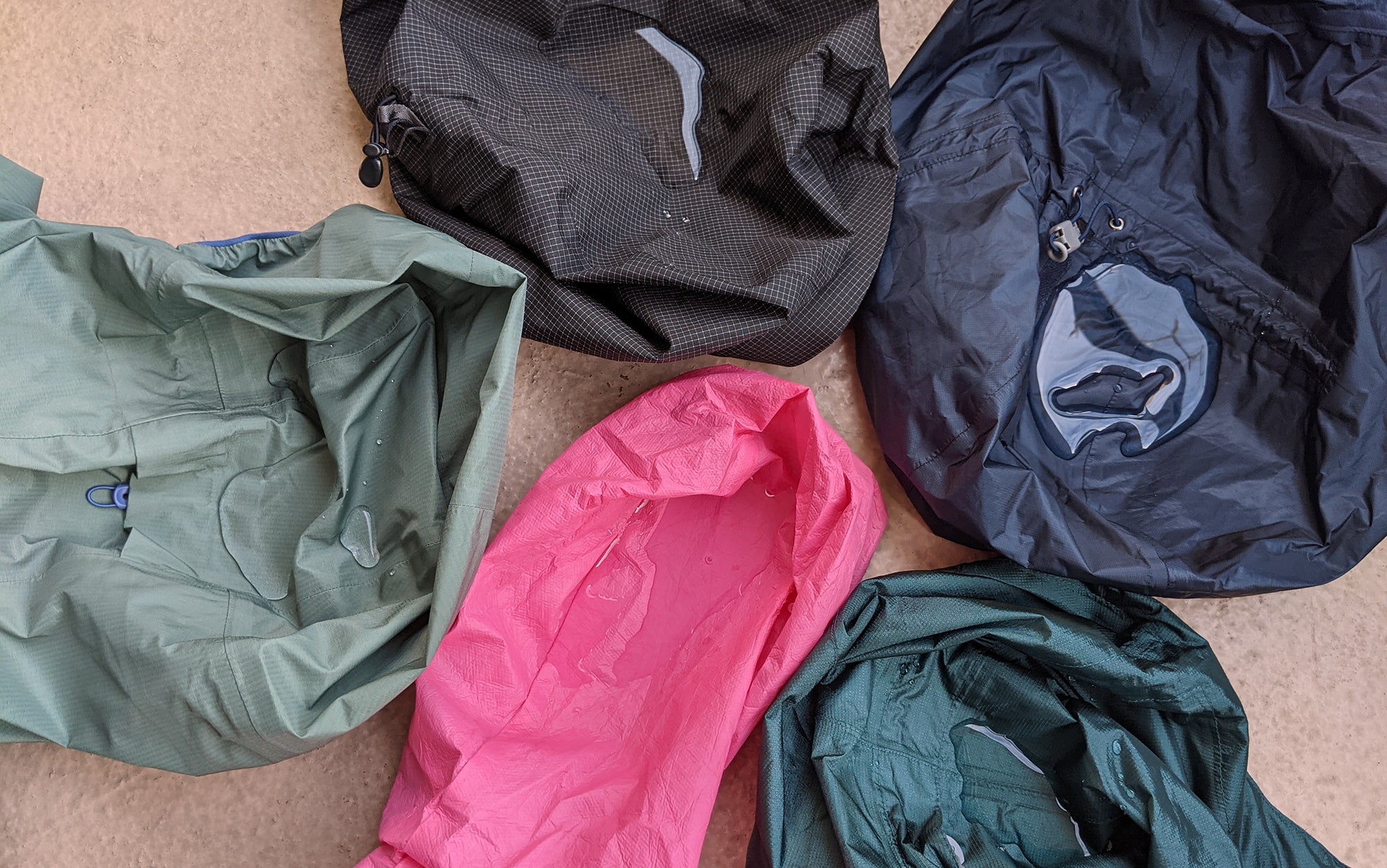
Shower Test
For this test, I hung each rain jacket on a clothes hanger with one of the best hiking shirts underneath it. It was hung inside of my shower below a shower caddy. The shower was then turned on for an hour for each weatherproof rain jacket (it was winter in the Pacific Northwest when this test was conducted, so water usage was less of a concern), to assess how well weak points, like zippers and seams, kept water off of the shirt underneath. Next up was the wind test, which was conducted using a small (but mighty) Vornado fan. Each rain jacket was given a qualitative rating on how well it did at blocking the wind.
Durability Test
To do this, I snagged clippings of Oregon grape and Himalayan blackberry, along with a rough stone (in the event you end up doing some light scrambling in your rain jacket). Each was then brushed lightly against the lightweight jackets, to mimic the effect of brushing against brush while out in the field, to see if it ripped the material. In addition to the above, I also weighed each packable rain jacket and considered additional details such as coverage, price, and extras, such as pit zips.

Weight
Jacket weights were checked using a kitchen scale.
While I handled the initial round of testing exclusively, additional testing has been performed by gear testers in Utah, Alaska, and California.
The Best Backpacking Rain Jackets: Reviews & Recommendations
Best Overall: Arc’teryx Beta LT
Arc’teryx
Key Features
- Sizes: Men’s XS-XXXL; women’s XXS-XXL
- Price: $450
- Weight: 8.5 ounces
- Material: 3L GORE-TEX
- Pit Zips: No
- Pockets: Two zip pockets at the waist
Pros
- Most waterproof jacket in my test
- Most wind-resistant jacket in my test
- Durable
Cons
- Expensive
- Heavier than other rain jackets I tested
- No pit zips
The Arc’teryx Beta LT was the most waterproof, wind-resistant jacket in my test, and incorporated a number of features that guaranteed that not one inch of your insulation layer or baselayer will get wet. The generous hood (even the puffiest of puffers will fit under this one) has cinch cords both at the back and by the chin so that you can get a secure fit, while the cuffs have velcro tabs that you can tighten when the wind picks up or loosen again when you need to cool off a bit. This was also one of the few jackets that I looked at that incorporated a noticeable drop-tail hem.
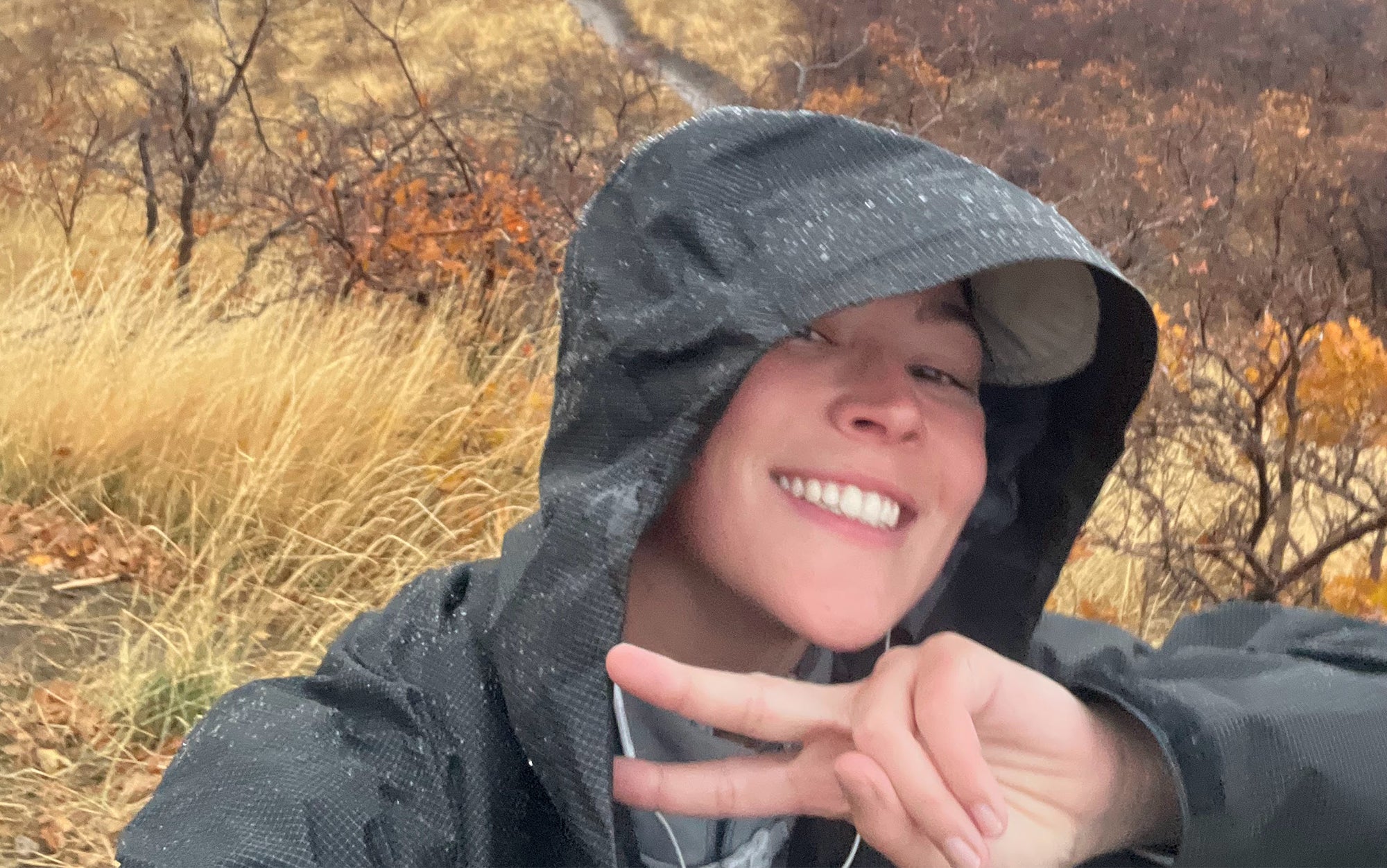
There are a few downsides to the Arc’teryx Beta LT. Individuals who work up a sweat easily will likely notice the lack of pit zips (the zippers that run underneath your armpits) while UL purists will scoff at the weight—at least until they land in their first serious downpour. But the biggest one is the price, which is over a hundred dollars more than the next closest jacket I looked at and fifteen times more expensive than my budget pick.
Best UL: Montbell Versalite
Montbell
Key Features
- Sizes: Men’s S-XL; women’s S-XL
- Price: $250
- Weight: 5.7 ounces
- Material: GORE-TEX Infinium Windstopper
- Pit Zips: Yes
- Pockets: Two zip pockets at waist
Pros
- Very lightweight
- Reasonably water resistant and wind resistant
- Has pit zips
Cons
- Not suitable for extreme conditions
Let’s get the tough part out of the way first: If you are headed into conditions that could be described as “torrential,” you should probably leave this one in your closet. But if you’re looking at more typical rain conditions—the light mist of the Pacific Northwest or short-but-intense squalls of the East Coast—then the Montbell Versalite is an excellent choice. It passed the shower test with flying colors and after the twenty-four waterproofing test (and are you really going to be out in the rain for twenty-four hours?) it was only slightly damp underneath, indicating a high degree of water resistance.
This wasn’t quite the lightest ultralight rain jacket in my test, but the extra features it incorporated (accounting for that extra ounce of weight) upped its performance for big adventures. The biggest of these is the zipped pit vents, essential for letting you cool off and air out when the sweat starts to pick up. It also has (albeit more minimal that the Arc’teryx Beta LT) velcro cuffs and cinches at the hem as well as the back of the hood and at the neck, which will help to keep out cold gusts when the wind kicks up.
Most Eco-Friendly: Patagonia Storm10
Patagonia
Key Features
- Sizes: Men’s XS-XXL; women’s XXS-XL
- Price: $330
- Weight: 7.8 ounces
- Material: H2No Performance Standard
- Pit Zips: Yes
- Pockets: Two zip pockets at waist; one zip pocket at left chest
Pros
- Fair-trade certified
- Contains 87 percent recycled nylon
- Has pit zips
Cons
- Some moisture snuck in during the shower test
- Expensive
So, as it turns out, creating a perfectly waterproof, windproof rain jacket isn’t exactly the most environmentally friendly process. In recent years, there has been greater awareness around the dangers of some of the chemicals, including PFAS, that are used to waterproof outdoor gear, and commitment by some of the more forward-looking brands to start to rectify the problem.
While this is an ongoing issue that none of the backpacking rain jackets I looked at got exactly right, the one that got the closest to hitting the mark was the Patagonia Storm10. In addition to being fair-trade certified (which looks at whether the workers who make the apparel are being paid a sustainable wage), it also contains 87 percent recycled nylon.
Despite being one of the more expensive rain jackets I looked at, the Patagonia Storm10 struggled during the shower test, with some moisture evident on the hiking shirt underneath. Its waterproof fabric, however, easily passed the waterproofing test.
Most Inclusive Sizing: Outdoor Research Helium
Outdoor Research
Key Features
- Sizes: Men’s S-XXXL; women’s XS-4X
- Price: $159
- Weight: 6 ounces
- Material: Pertex Diamond Shield Diamond Fuse 2.5L
- Pit Zips: No
- Pockets: One zip pocket at left chest
Pros
- Widest range of sizes of all the rain jackets I looked at
- Lightweight
Cons
- Least water resistant rain jacket I looked at
One common piece of advice you hear with backpacking rain jackets is that you’re going to want to size up. That’s because you might have an insulation layer, base layer, and maybe even a fleece underneath that shell. But there are also times where you might want a more minimal approach: like when you’re hoofing it up a hill during a summer squall. So Outdoor Research’s approach to sizing—basically, include every option under the sun—is exactly what I wanted to see. The men’s sizing for the Helium goes all the way to 3X (that’s a 56 inches chest circumference) while the women’s goes all the way out to 4X (59 inches): the largest of any backpacking rain jacket I looked at.
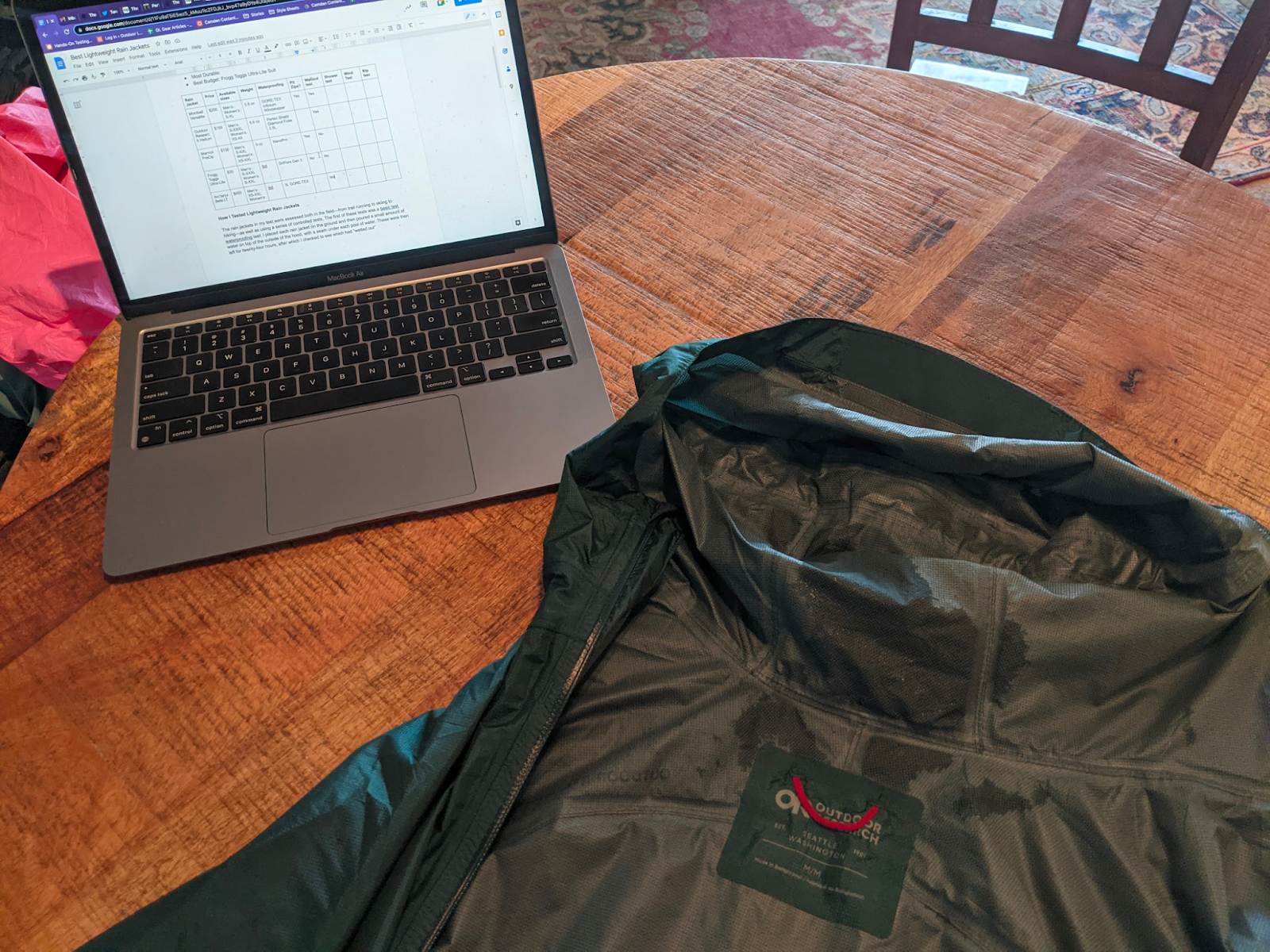
Recording the results of the 24-hour waterproofing test for the Outdoor Research Helium.
Now the downside: This one really isn’t all that water resistant, soaking through during the 24-hour waterproofing test. If you’re expecting sunny skies with only a five percent chance of rain, it’s fine to pack, but if you need to account for multiple days of rain, this one isn’t going to provide the protection that you need.
Best Budget: Frogg Toggs Ultra-Lite Suit
Frogg Toggs
Key Features
- Sizes: Men’s S-XXXL; women’s S-XXL
- Price: $30
- Weight: 4.6 ounces
- Material: DriPore Gen 2
- Pit Zips: No
- Pockets: None
Pros
- Very, very lightweight
- Inexpensive
- Comes with rain pants
Cons
- Not waterproof in stormy conditions
- Less durable than other rain jackets
Dollar for dollar, the Frogg Toggs Ultra-Lite Suit provides the best protection of any backpacking rain jacket I looked at. Partly because the Frogg Toggs are extremely cheap, but also partly because these are a pretty good shell layer. While the jacket performed the worst in the shower test (a less robust front zip seems to have been the failure point), there was no leakage during the 24-hour waterproofing test, and they also proved surprisingly wind resistant. It would have challenged the Arc’teryx Beta LT for the top spot in that category if it had included any kind of cinch at the hem (which allowed for a substantial breeze to sneak through).
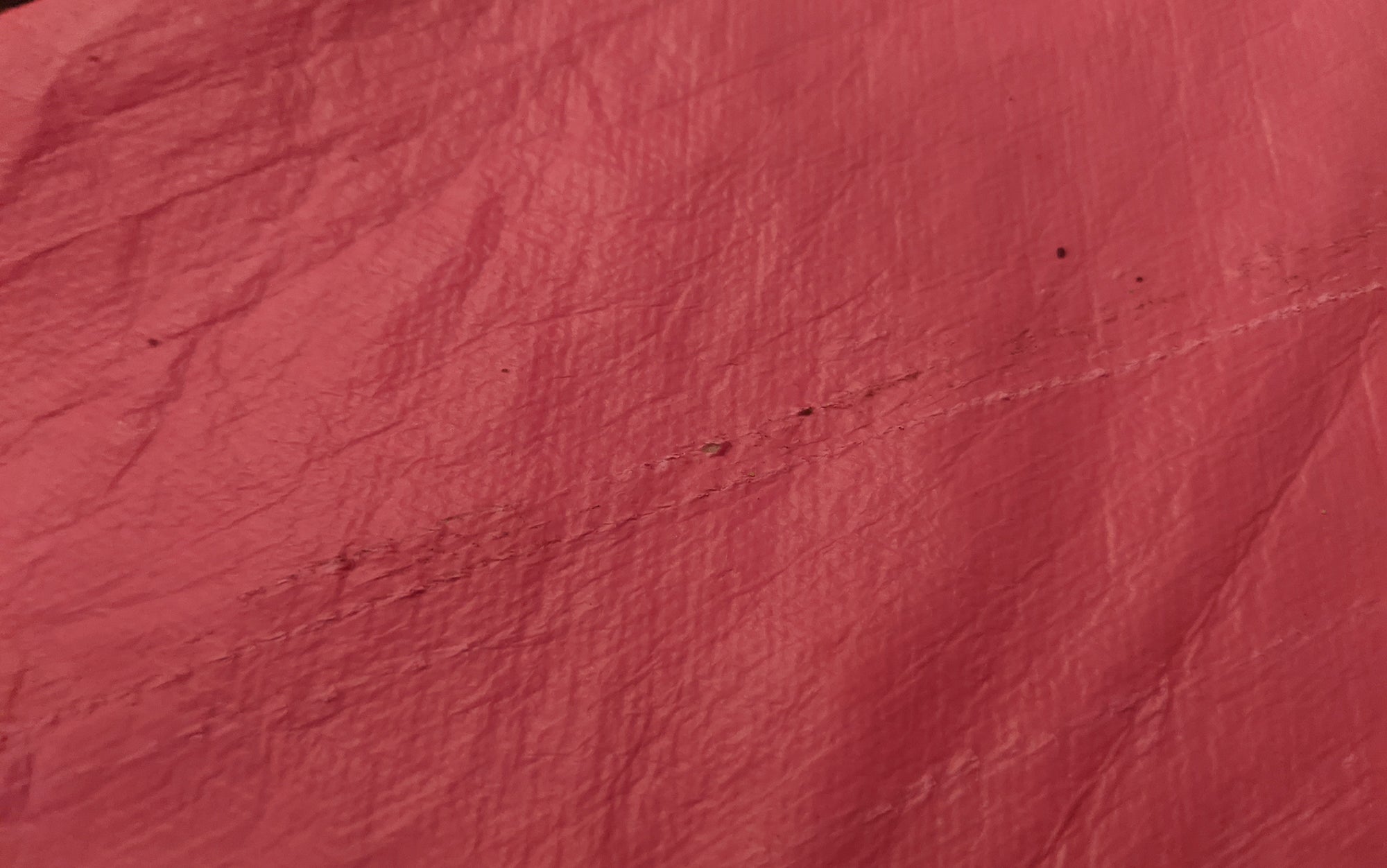
While the Frogg Toggs Ultra-Lite came in at both an eye-poppingly low price and weight, it was the only rain jacket in my test to pick up scrapes during the durability test, specifically when I scraped the jacket with a rock. Do not take this one on your next scrambling trip, or really any place where you anticipate serious blow downs. But thru-hikers on a budget should still consider this one. After all, you could buy three and still pay less than the next closest priced layer (the Montbell Versalite). And you get free rain pants.
The Rest of the Field
We tested, and liked the Outdoor Vitals Tushar rain jacket. It kept our tester dry when a serious downpour kicked up in Escalante National Monument, and even breathed (the small pit zips didn’t hurt either). Our only complaint is the sizing: this one runs unusually small. While we called in a large, our medium-testers found it to be a tight fit. (It was ultimately by someone who wears a size small or extra small.) Size up at least one size, two if you are on the margins.
What to Consider Before Buying a Backpacking Rain Jacket
Weight
Since weight is typically a major concern of backpackers, I only looked at shell layers that weighed less than 10 ounces. If weight is not one of your primary concerns, you’ll be better off with the best hunting rain gear or the best rain gear for fishing. While there are always trade-offs when you start cutting the ounces off of outdoor gear, with rain gear the stakes go up considerably. If you’re interested in cutting weight, but have a certain level of performance that you’ll still need to get out of your rain gear to meet it—keep reading.
Read Next: Best Packable Down Jackets
Material
There are seemingly endless proprietary waterproofing options out there, but for lightweight rain jackets, most are silnylon, silpolyester, or polytetrafluoroethylene (PTFE), often with an additional durable water resistant (DWR) coating. How well any of these work at actually keeping out rain depends on a number of factors (hence the proprietary aspect), but generally PTFE (which is what GORE-TEX is made out of) will hold off rain for longer than other materials. In this test, we looked at whether each material could resist rain for twenty-four hours without wetting out.
Breathability
There’s a general sense in the outdoor community that “breathable rain gear” is an oxymoron and, for all intents and purposes, this is true. While breathable rain gear does provide some release of heat and moisture, it’s not going to be enough for individuals that are regularly soaking their raingear from the inside out (conversely, people who don’t sweat much—like this gear reviewer—won’t benefit much from this feature at all). For this story, I did not test for the actual breathability of each fabric, but I did consider other ways each rain jacket could release heat (such as pit vents).
Durability
Lightweight rain jackets can be delicate, and sometimes rip or shred when you brush up against various types of foliage. If you know that your rain gear will be subjected to rougher environments—dense foliage, rocky scrambles—then pay attention to how well it does on the durability test.
Read Next: Best Hiking Jackets
FAQs
Q: Why do jackets stop being waterproof?
Some jackets are only waterproof because they have a durable water repellent coating. When the coating wears off, the water resistance is lost. Others may suffer damage to their Goretex or water repellant liner, allowing water to seep in over time. Many rain jackets also have an upper limit on the amount of water they are able to repel. In too strong of downpour, they may fail.
Q: How often should you wash a rain jacket?
During seasons of heavy use, try to wash your rain jacket once a month. This will help extend its lifespan by eliminating any sweat or dirt that may build up and impair the jacket’s water repellency. Follow manufacturer instructions as to detergent and wash cycles. If specialized washes are called for (or even if they’re not), consider using a specialized cleaner like the Nikwax Tech Wash.
Q: Should rain jackets be tight or loose?
Rain jackets should be loose enough that you can fit an insulation layer and a baselayer beneath them. The colder your climate, the looser the fit should be.
Final Thoughts
After putting five top rain jackets through a series of field tests, I’m confident that (assuming money is no object) the Arc’teryx Beta LT is the best backpacking rain jacket you can buy. If weight is your primary concern, the Montbell Versalite is the best lightweight option I looked at, while the Frogg Toggs Ultra-Lite Suit provides impressive waterproofing for a surprisingly low price.
The post The Best Backpacking Rain Jackets of 2023 appeared first on Outdoor Life.
Articles may contain affiliate links which enable us to share in the revenue of any purchases made.
Source: https://www.outdoorlife.com/gear/best-backpacking-rain-jackets/

